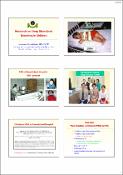บทคัดย่อ
Obstructive sleep apnea (OSA) is the most common sleep disordered
breathing in children. Research publications on childhood OSA in Thailand have
been started since 1997. At Ramathibodi Hospital we found that of 39 children
undergoing polysomnography during 1994-1997, 14 (36%) were found to have
severe OSA (OA > 10/hour of total sleep time and SpO2 < 75%). In the south part of
Thailand, Anuntaseree et al. have conducted epidemiological studies and showed
that in children aged 6-13 years, the incidence of habitual snoring and OSA were
8.5% and 0.7% respectively. In 2001, Eiamudomkal et al. reported 11 out of 24
children with OSA having pulmonary hypertension and nadir SpO2 < 65% was shown
to be the most important predictive factor. Khositseth et al. later showed that QT
dispersion presented on ECG was significantly increased in childhood OSA,
particularly in obese children. Thai children more likely have late diagnosis and thus
more complications related with OSA. The main reasons are due to shortage of
pediatric sleep laboratory and sleep specialists. Therefore alternative tests should
be sought out. In 2000, we conducted a parent questionnaire research and found
that it is not useful because of low specificity and sensitivity. In 2003, we used video
symptoms questionnaire in which the parents compared their own child’s nighttime
symptoms with our video. The results showed that the specificity was closed to
100% but the sensitivity was too low. Even if we modified the report of symptoms to
visual analog scale, the results still was inconclusive. In 2004, overnight pulse
oximetry was used to record SpO2 every 2 seconds and then create a dot graph in
which Y axis was SpO2 values and X axis was time when the patient was sleeping.
We showed that if there were more than 3 clusters of desaturation, the positive
predictive value and specificity were closed to 100% which confirmed the findings of
Canadian investigators. Therefore pulse oximetry has been preferably used as a
screening test where PSG is not available. Nongnaphat Chirawutthinan, our fellow,
recently conducted a nice study showing that video clips recorded by smart phones
at home were a promising method to screen childhood OSA. If paradoxical chest
movement, continuous snoring and subcostal retractions were detected on a 5-
minute clip, that patient most likely had moderate to severe OSA and needed early
interventions. It is hoped that in the future when OSA attracts more public attention,
the patients will be diagnosed and managed earlier and more appropriately.


